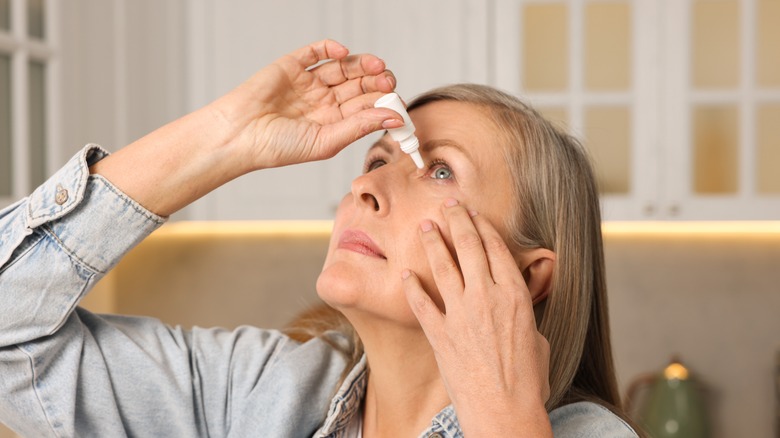
Facundo Diaz Montes/Getty Images
As much as there’s quite a bit of beauty that comes with getting older, like all that wisdom and those lovely laugh lines, there are also many things that go downhill. And, for many people, it’s once they’re in their early 50s that illnesses, ailments, and other physical issues start rearing their ugly heads. Sjögren’s syndrome, for example, is one of those things.
According to a continuing education activity published in StatsPearls, Sjögren’s syndrome is a systemic autoimmune disorder that affects fluid production in the body, resulting in dry eyes and dry mouth, as well as joint pain (via National Library of Medicine). The article further states that Sjögren’s syndrome is not a rare condition, with between 0.5% to 1.0% of people having been diagnosed with it, most of whom are women over the age of 50. But why are people over 50 and women mostly at risk?
“As we age, our immune system undergoes significant changes with a higher risk of autoantibody production and reduced ability to distinguish what is ‘self’ and what is a ‘foreign pathogen’ thereby increasing the chance of our immune cells attacking healthy cells in our body,” Dr. Jason Singh, Chief Medical Officer of One Oak Medical Group, told Health Digest, explaining that women are more likely to get Sjögren’s syndrome because of how estrogen impacts immune function as they age. “[Other] risk factors include family history of autoimmune disease, prior viral infections that can trigger autoimmune responses, chronic stress, and smoking,” he added. Since there’s a chance that you may find yourself with a Sjögren’s syndrome diagnosis in the future, it’s important to know the signs.
Sjögren’s syndrome warning signs to be aware of

New Africa/Shutterstock
Because Sjögren’s syndrome affects fluid production, the most prominent warning signs are chronic dry eyes and dry mouth. This isn’t just feeling like you need to drink more water or start using eye drops, because we’re not talking about run-of-the-mill dryness. In fact, the dryness can become so intense that it can start to impact your daily life. “Patients will note feeling sand in their eyes and difficulty swallowing dry foods,” said Singh. While these symptoms certainly make sense because of how Sjögren’s syndrome disrupts normal bodily fluid production, these aren’t the only signs.
According to Singh, you can also expect joint pain and swelling, ongoing fatigue, and swollen salivary glands. “These symptoms can develop gradually and might be mistaken for normal aging or other conditions,” he said. Because of this, it’s important not to disregard any of these symptoms, especially if they’re all occurring at once. “Early diagnosis and treatment can help manage symptoms and prevent complications,” said Singh.
When to see a doctor about Sjögren’s syndrome

Thomas Barwick/Getty Images
Although you might dismiss these symptoms at first, assuming it’s just old age doing its thing, it’s important to realize that with age comes a lot of issues that shouldn’t be swept under the rug and dealt with later. Even if your symptoms don’t end up being because of Sjögren’s syndrome, they could be indicative of something else. In other words, if you’re in any sort of discomfort and it’s making simple functioning near impossible, you need to get yourself to the doctor.
According to the National Institute of Arthritis and Musculoskeletal and Skin Diseases, Sjögren’s syndrome can be found through eye tests, salivary tests (which may include a biopsy), and/or blood tests. While there’s no cure for Sjögren’s syndrome, there are treatments and, as Singh pointed out, the earlier the diagnosis the better. Sjögren’s syndrome generally isn’t deadly, but if left untreated it can lead to increased risk of lymphoma or even premature death, per Penn Medicine.
Credit: healthdigest.com










